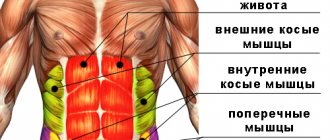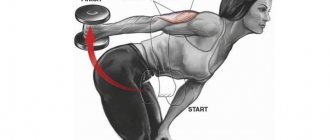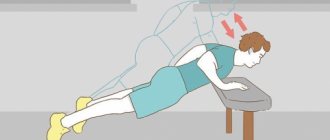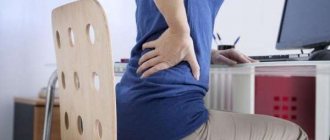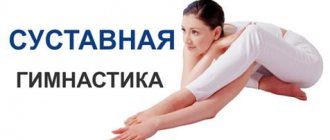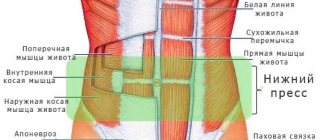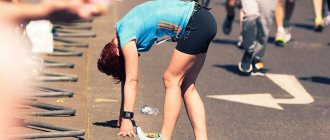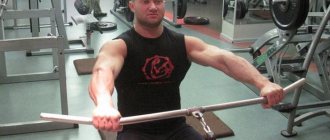Why is this a problem
The condition of your lower back depends on the tilt of your pelvis. When the pelvis is in a neutral position, the back retains normal physiological curves; when the pelvis is tilted forward, an excessive deflection is created in the lower back, and when the pelvis is tilted backward, the lower back becomes flat.
Neutral position and different pelvic tilts
All physiological curves of the spine are necessary for a healthy back, and if one of them disappears, it negatively affects all parts, including the thoracic and cervical.
A flat lower back impairs shock absorption, so the load on the spine can result in pain, protrusion and hernia, problems with nerve roots, stiffness and muscle pain.
Causes
Pain in the lower back appears due to the development of inflammatory, traumatic and tumor pathologies in it.
Serious diseases that cause lower back pain when bending forward include:
Development of osteochondrosis, radiculitis, myositis
Radiculitis refers to the development of inflammation in the roots of the spinal nerves. Myositis is the development of an inflammatory process in muscles and ligaments. Back pain may worsen when you turn your torso. A person is tormented by pain on both sides of the spinal column. These diseases often bother summer residents who work hard on their plots of land in the spring and autumn and lift heavy objects. They are often in a draft and expose their body to hypothermia.
In addition, the development of radiculitis is associated with excessive compression of the nerve roots by metastases, displacement of the vertebrae, and the appearance of a hernia in the intervertebral discs. In this case, a person is bothered by unpleasant sensations only in one side. If a person develops myositis, then his back hurts when bending over. When performing this action, the muscles contract. As a result, the pain becomes stronger.
With osteochondrosis, a person suffers from severe pain in the lower back when bending the head forward. The pain is caused by pinched nerve roots. Not only these, but also other diseases that affect the lower back usually appear with frequent hypothermia of the body.
Inflammatory diseases and ankylosing spondylitis.
When an inflammatory process develops in the lumbar region, a person has to reduce his physical activity due to pain and cannot bend over normally. If he is bothered by acute pain, his heart rate and body temperature increase. The development of ankylosing spondylitis is associated with the spread of an inflammatory process in the body. But in this case, inflammation appears due to disruption of the immune system. This disease affects the lower parts of the spinal column, sacrum, and pelvic bones. Ankylosing spondylitis develops very slowly and gradually reduces a person’s motor activity. As a result, the intervertebral joints become fused, and the person is unable to bend the body forward normally.
Intervertebral hernia
The appearance of herniation in the intervertebral discs, spinal column injuries and disc displacement. When injured, a person suffers from sharp pain in the lower back when bending forward, especially if he lifted a heavy object. Typically, such pain bothers loaders, weightlifters, and gymnasts. In addition, a person’s limbs become numb, and in severe cases, sensitivity in them may completely disappear. Additionally, they may be bothered by pain in the lower back when tilting the head, which runs along the entire nerve. Because of it, the patient cannot straighten his leg freely when lying on his back. Doctors call these signs “tension symptoms.” If a person develops a hernia or vertebrae are displaced, he often has to look for a body position in which he will not feel pain.
Development of urolithiasis, glomerulonephritis, pyelonephritis
In most cases, they cause a person to experience acute pain in the lower back during extension. Painful sensations when a person bends forward appear when he develops urolithiasis. This is due to the fact that the stone begins to move due to the motor activity of the spinal column. If a person develops glomerulonephritis and pyelonephritis, then pain occurs not only when the lower back is tapped, but also when the spine is flexed and extended. Additional causes of lower back pain are associated with the development of inflammation in the pancreas, the appearance of an atypical form of heart attack, and pleurisy.
Development of tumor formation and metastases in the back area
These are the most dangerous causes of pain in the lumbar region. When they occur, pain appears not only in the spinal column, but also in other organs, in the kidneys, in the stomach and intestines. A person begins to feel worse and worse every day, he suddenly loses weight, metastases compress and affect the spinal cord. In this case, the pain intensifies gradually or it can be immediately acute. Acute pain in the lower back when bending the torso forward usually appears due to a vertebral fracture. It breaks down due to the penetration of metastases into it. Metastases in the spine occur in the presence of tumors in the pelvis, mammary glands, and lungs.
Why does the pelvis tilt backward?
The main causes of this disorder are long periods of time spent sitting and incorrect body position.
If you maintain an incorrect position for 6-8 hours every day, your body will adapt to it. As a result, some muscles become too tight, while others become too stretched and weak.
Stiff muscles
Weak muscles
Stiff muscles pull your pelvis along with you and tilt it back, not only when you sit, but also when you stand, walk or squat.
Corrections
In cases of anterior pelvic tilt, the pelvis can be gradually returned to a neutral position using various stretching and strengthening exercises. These exercises include the following:
Squats
Squats strengthen your glutes, hamstrings, and other leg muscles.
- Stand with your feet slightly wider than wide. Turn your fingers slightly outward.
- Squeeze your abdominal muscles and keep your back neutral.
- Breathe in. Lower your hips back and down, causing your knees to bend until your thighs are parallel to the floor. Your knees should not extend beyond your toes and your heels should be firmly planted on the floor.
- Exhale and slowly return to the starting position.
- Repeat 10 to 20 times.
Pelvic tilt
This exercise helps strengthen your abdominal muscles.
- Lie on the floor, face up, with your knees bent.
- Squeeze your abdominal (stomach) muscles to keep your back flat against the floor. Bend your pelvis slightly upward.
- Hold this position for 10 seconds.
- Repeat for five sets of 10 reps.
The standing hind leg is raised
This exercise stretches the muscles of the back and buttocks, strengthening the abdominal muscles.
- Start on all fours on the training mat. Your hands should be directly under your shoulders and your knees directly under your hips. The weight should be evenly distributed between the hands and knees.
- Tighten your abdominal muscles.
- Bring your right leg back in line with your body, keeping your toes pointed and your legs straight. Don't twist your back.
- Hold your leg in position for 5 seconds. Lower and repeat 10 times.
- Flip the sides over and repeat the above process with the extra leg.
Hip flexor tilt
This stretch helps loosen and lengthen tight hip flexor muscles.
- Place your knees over your left knee, ensuring that your right knee is directly above your right ankle.
- Place both hands on your right thigh for stability. Make sure your spine is high and straight.
- Tighten your glutes and abdominal muscles and keep your pelvis in a neutral position.
- Lean forward into your right hip, ensuring that your pelvis and back remain stable. There should be a stretch in the hip flexor and inner thigh.
- Hold this position for 30 seconds. Repeat five times, trying to stretch a little more with each repetition.
- Flip sides and repeat the above process to stretch the other hip.
Notched bridge
This exercise targets the muscles of the buttocks and hamstrings.
- Lie on the floor, face up, and knees bent.
- Place your feet wide.
- Squeeze your abdominal muscles so that your back is flat against the floor. Keep your abdominal muscles engaged during the exercise.
- Exhale and lift your hips off the floor so that your upper body and thighs form a straight line.
- Inhale and gently lower your body to the floor.
- Repeat 10 to 20 times.
Plank
The plank exercise helps target your abdominal and back muscles.
- Lie face down on an exercise mat.
- Place your hands on the mat, palms down. Keep your hands directly under your shoulders.
- Tighten your abdominal muscles and thigh muscles.
- Slowly lift your upper body and hips off the ground into a push-up position. Keep your body stiff and even. Make sure your abdominal muscles are engaged during the exercise.
- Hold plank pose for as long as possible, working up to 60 seconds. Gently lower your body to the floor.
Prevention Tips
The following tips may reduce your risk of developing anterior pelvic tilt.
- Avoid sitting for long periods of time. Those who have jobs and other roles that require sitting for long periods of time should take regular breaks to walk or stretch.
- Engage in regular physical activity. This should include both stretching and strengthening exercises.
- Ensure correct posture, especially while sitting. A comfortable and useful workspace with a properly positioned desk, screen and chairs is important.
How to tell if you have a posterior pelvic tilt
Two finger test
Stand up straight, place one finger on the protruding pelvic bone in front, and the other on the protruding pelvic bone in the back. If your pelvis is tilted backward, the finger on the front bone of the pelvis will be significantly higher than the finger on the back.
Movement test
Stand in front of a mirror or ask your partner to take a photo of you to evaluate your posture from the outside. Bend forward, do a squat, or simply sit on a chair.
Rounded back during squats
If this causes your lower back to round, it may be due to a posterior pelvic tilt.
Wall test
Wall Test
Sit next to a wall, press your back against it and stretch your legs forward.
If you can't straighten your legs without twisting your lumbar spine, you have a posterior pelvic tilt.
Exercise 3: Bridge with Leg Straightening
1. Lie on your back. Bend both legs at the knee joints.
2. Lift your pelvis up as much as possible. In this case, the shoulders should remain on the floor.
3. While in this position, straighten one leg and hold for 5 seconds.
4. Return this leg to the starting position and do the same with the other leg.
5. After this, return to the starting position and do 2 sets of 10 repetitions.
This exercise trains your glutes, glutes, and abdominal muscle control. During the exercise, there should be no rotation of the body and/or flexion in the hip joint or supporting leg.


